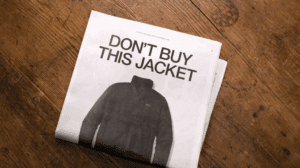
5 memorable sustainable marketing campaigns

Sustainability is everywhere in 2025, and it’s more important than ever for brands to show that they care. It’s not enough to just have great products anymore – people expect companies to take responsibility for the planet, too. That’s where sustainable marketing comes in. It’s a way for brands to show they’re truly committed, get people thinking differently, and even inspire them to change their habits.
Hi, I’m Loren, and I am a Content Account Manager at Embryo! In this blog, I’m going to be taking a look at what I think are 5 of the most memorable sustainable marketing campaigns from around the world.
Why Sustainable marketing campaigns matter
With a significant 60% of people worldwide willing to change their buying habits to lessen their environmental footprint, now is the time for brands to take a look at their sustainability efforts.
Companies creating sustainable marketing strategies can:
- Build stronger loyalty and emotional connections with their audience
- Stand out in competitive markets
- Help educate and empower consumers to make positive environmental choices
- Show alignment with global sustainability goals
It’s extremely important for brands to make sure that with any marketing they do, they stay authentic, as greenwashing or creating a misleading sustainability image can do more harm than good. The most memorable marketing campaigns, like the ones I talk about below, combine creativity with real environmental impact.
5 memorable sustainable marketing campaigns
Trainline’s – I Came By Train
Starting us off is Trainlines ‘I Came By Train’ campaign, launched in 2022, which I think is a great example of how storytelling can make the everyday commute feel special. This campaign helped celebrate the benefits of train travel, particularly its positive impact on the environment, while also highlighting the enjoyable experiences it can offer.
The campaign concept
Trainline took to social media to share real-life passenger experiences, helping to show how train travel can connect people to new places and reduce their carbon footprint. Passengers were able to share their experiences online using the hashtag #ICameByTrain, creating a fun and engaging way to celebrate personal travel experiences.
As well as the social content, well-known singer-songwriter Craig David created a song for the campaign called ‘Better Days (I Came By Train)’. The song served as a ‘love letter to Mother Earth,’ highlighting the environmental benefits of choosing train travel. It was supported by an animated music video and a dedicated website, where customers could pledge to swap one journey for rail, creating a clever way to get people thinking about how they travel and encourage more sustainable choices.
Why it worked
I think Trainline’s ‘I Came By Train’ campaign is a great example of sustainable marketing. By combining genuine customer stories with fun interactive social campaigns and music from a high-profile artist, the campaign created a real sense of community, helping promote sustainable train travel and strengthen the brand’s connection with its customers.
Adidas – Run for the Oceans
Adidas’ ‘Run for the Oceans’ campaign is the perfect example of mixing marketing with real-world environmental action. Launched in 2017 through a partnership with Parley for the Oceans, the campaign urged people from across the world to run while raising awareness of the problems of plastic pollution in the oceans.
The campaign concept
The concept was simple but powerful. For every kilometre run that was logged in the Adidas Running app, the brand would remove an equivalent amount of plastic from the oceans. The campaign also included limited-edition shoes and apparel made from recycled ocean plastic, which helped link consumer action directly to environmental impact.
Why it worked
What I think makes ‘Run for the Oceans’ stand out is its interactive approach. This was about getting consumers up and actively involved. This helped encourage physical activity, creating a deeper, more emotional connection for the people who participate, which has now spread to millions around the world.
Nescafé – 80 Degrees
In 2024, Nescafé launched its 80 Degrees campaign, shining a light on the benefits of brewing coffee at a lower temperature. They shared research showing that coffee brewed at 80°C not only keeps more of its natural flavours, but also uses less energy than other, more traditional brewing methods.
The campaign concept
Nescafé’s campaign was all about encouraging people to think differently about how they make their coffee. The 60-second cinematic ad, directed by Omri Cohen, followed coffee lovers from around the world as they waited for their pots and kettles to reach the perfect temperature. Nescafé showed how even small changes, like boiling water to a slightly lower temperature, can have a big impact on the environment. To bring the message to life, the campaign also featured a colour-changing thermal sticker that let people know when their water had hit that ideal 80°C.
Why it worked
What I love most about this campaign is its focus on small yet meaningful everyday changes the average person can make. Instead of telling people to buy something new or completely change their lifestyle, Nescafé was able to show how even just small, simple changes, like lowering the temperature when making your morning coffee, can make a real difference. By connecting sustainability with the enjoyment of a good cup of coffee, the campaign felt genuine and easy to relate to, which is why it stands out to me as a great sustainable marketing campaign.
Tony’s Chocoloney – Sweet Solutions
Another great example of a memorable sustainability campaign is Tony Chocoloneys ‘Sweet Solutions’, which launched in 2021. This campaign aims to challenge big chocolate companies when it comes to unethical practices in the cocoa industry.
The campaign concept
Tony’s got to work creating four limited-edition chocolate bars that mimicked other well-known brands, including KitKat, Toblerone, Twix, and Ferrero Rocher. By doing this, they aimed to prove that it’s completely possible to make the delicious chocolate we all know and love while remaining entirely ethical. Each bar featured Tony’s signature bold branding and a powerful message inside the wrapper, encouraging consumers to reflect on where their favourite chocolate really comes from and to call for greater accountability from major confectionery companies.
Why it worked
By borrowing the look of household favourites, Tony’s was instantly able to capture attention and spark important conversations about the cocoa industry. It challenged both customers and competitors to take a step back and reflect on their choices when it comes to chocolate. The campaign reinforced Tony’s image as a changemaker in the industry, inspiring people to see that ethical chocolate should – and can – be the norm.
Patagonia – Don’t Buy This Jacket

Patagonia’s ‘Don’t Buy This Jacket’ campaign launched on Black Friday back in 2011. It is one of the most iconic examples of a sustainable marketing campaign, as it encouraged consumers to stop and think before making unwanted purchases, even of Patagonia’s own products.
The campaign concept
Instead of pushing sales, Patagonia challenged overconsumption, turning conventional marketing on its head. Using a full-page ad in the New York Times, Patagonia delivered the bold message of ‘think before you buy.’ The brand encouraged people to repair, reuse, and recycle what they already owned, even sharing handy tips on how to make their jackets last longer. By focusing on getting the most out of what you have instead of pushing new products, Patagonia made sustainability feel realistic and achievable for everyone.
Why it worked
I think this campaign worked so well because the messaging was bold and completely in line with Patagonia’s brand. It got people talking about responsible consumption and positioned Patagonia as a true leader in sustainability.
Even though the campaign was actively discouraging immediate purchases, it actually helped boost brand loyalty, showing that authenticity and purpose-driven marketing can have a real impact.
How to make your sustainability campaigns stand out
Looking at these five marketing campaigns, there are a few things that really stand out and make them work:
- Being real – People know when a brand is using sustainability as a buzzword. The campaigns that stand out are the ones where it feels like the brand actually cares.
- Sharing knowledge – This is about teaching your consumers something alongside selling a product, like how Nescafé showed us a more energy-efficient way to brew coffee; it’s practical and helpful.
- Getting people involved – The campaigns that get you to take part in something, like Adidas’ running challenge, feel way more personal. You become part of the action.
- Making it easy to act – The best campaigns give you simple ways to make actual change. It’s the small things that can make a difference.
- Making a bold statement – Memorable campaigns often make you think twice. Patagonia’s ‘Don’t Buy this Jacket’’ is a great example; it flips the usual shopping mindset and really stands out.
Purpose-driven marketing is about being authentic, offering real value, and making sustainability feel like something anyone can be part of.
Take your marketing strategy to the next level with Embryo
And there you have it, the top 5 most memorable sustainable marketing campaigns! I hope you learnt a few extra hints and tips to inspire your next marketing campaign.
At Embryo, we’re constantly creating and executing marketing campaigns, whether that’s for ourselves or our wide range of clients. If you’re looking to make your brand stand out with purpose, contact us today. Let’s start the conversation!



